Reducing Global Warming Potential Impact of Bio-Based Composites Based of LCA
Abstract
:1. Introduction
2. Methods
2.1. Goal and Scope Definition
2.2. Functional Unit
2.3. System Boundaries and Quality of Data
2.4. Inventory Analysis
2.4.1. Data Assumptions and Description of the Inventory Data for Each Stage
Extraction of Hemp and Flax Fibers from Cultivation
Processing of Hemp and Flax Fibers
Production and Transportation of PLA Fibers
Production of Non-Woven Materials
Production of Composites
2.4.2. Allocation Procedure
2.4.3. Comparison Scenarios
3. Results
3.1. Environmental Impact of Cultivation of Hemp and Flax
3.2. Environmental Impact of Hemp and Flax Processing, and PLA Fiber Production and Transportation
3.3. Environmental Impact of Production of Non-Woven Materials
3.4. Environmental Impact of Production of Composites
4. Discussion
5. Conclusions
Supplementary Materials
Author Contributions
Funding
Institutional Review Board Statement
Informed Consent Statement
Data Availability Statement
Conflicts of Interest
References
- Piot, A.; Béjat, T.; Jay, A.; Bessette, L.; Wurtz, E.; Barnes-Davin, L. Study of a hempcrete wall exposed to outdoor climate: Effects of the coating. Constr. Build. Mater. 2017, 139, 540–550. [Google Scholar] [CrossRef]
- Fung, W.; Hardcastle, M. 7—Other Textile Applications. In Textiles in Automotive Engineering; Fung, W., Hardcastle, M., Eds.; Woodhead Publishing: Cambridge, UK, 2001; pp. 227–253. [Google Scholar] [CrossRef]
- Groz-Beckert. All the Latest Information from the Textile World, Trendsetter: Finer Fibres. Available online: https://www.groz-beckert.com/en/company/news/newsletter/felting/2011/m4_felting_nonwovenincars.html (accessed on 3 August 2022).
- Fung, W.; Hardcastle, M. 6—Product Engineering—Interior Trim. In Textiles in Automotive Engineering; Fung, W., Hardcastle, M., Eds.; Woodhead Publishing: Cambridge, UK, 2001; pp. 194–226. [Google Scholar] [CrossRef]
- Anand, S.C.; Brunnschweiler, D.; Swarbrick, G.; Russell, S.J. 5—Mechanical bonding. In Handbook of Nonwovens; Russell, S.J., Ed.; Woodhead Publishing: Cambridge, UK, 2007; pp. 201–297. [Google Scholar] [CrossRef]
- The European Parliament and the Council of the European Union. Directive 2009/28/EC of the European Parliament and of the Council of 23 April 2009 on the Promotion of the Use of Energy from Renewable Sources and Amending and Subsequently Repealing Directives 2001/77/EC and 2003/30/EC (Text with EEA relevance). Off. J. Eur. Union 2009, 140, 1–16. Available online: http://data.europa.eu/eli/dir/2009/28/oj (accessed on 12 June 2022).
- Stewart, R. Lightweighting the automotive market. Reinf. Plast. 2009, 53, 14–21. [Google Scholar] [CrossRef]
- Chen, J.Y. Reducing Noise in Automotive Interiors. In Textile Advances in the Automotive Industry; Shishoo, R., Ed.; Woodhead Publishing Limited: Cambridge, UK, 2008; pp. 198–228. [Google Scholar]
- De Beaus, N.; Carus, M.; Barth, M. Carbon Footprint and Sustainability of Different Natural Fibres for Biocomposites and Insulation Material. Hürth. August 2019. Available online: www.nova-institut.eu (accessed on 3 August 2022).
- Toffe, G.T.; Ismail, S.O.; Montalvão, D.; Knight, J.; Ren, G. A scale-up of energy-cycle analysis on processing non-woven flax/PLA tape and triaxial glass fibre fabric for composites. J. Manuf. Mater. Processing 2019, 3, 92. [Google Scholar] [CrossRef]
- Mohammed, L.; Ansari, M.N.M.; Pua, G.; Jawaid, M.; Islam, M.S. A Review on Natural Fiber Reinforced Polymer Composite and Its Applications. Int. J. Polym. Sci. 2015, 2015, 243947. [Google Scholar] [CrossRef]
- Farah, S.; Anderson, D.G.; Langer, R. Physical and mechanical properties of PLA, and their functions in widespread applications—A comprehensive review. Adv. Drug Deliv. Rev. 2016, 107, 367–392. [Google Scholar] [CrossRef] [PubMed]
- Ramaswamy, S.; Institut für Textiltechnik of ITA RWCH Aachen University, Aachen, North Rhine-Westphalia, Germany. Personal communication, 2013.
- Hu, R.; Lim, J.K. Fabrication and mechanical properties of completely biodegradable hemp fiber reinforced polylactic acid composites. J. Compos. Mater. 2007, 41, 1655–1669. [Google Scholar] [CrossRef]
- Hargitai, H.; Rácz, I.; Anandjiwala, R.D. Development of HEMP fiber reinforced polypropylene composites. J. Thermoplast. Compos. Mater. 2008, 21, 165–174. [Google Scholar] [CrossRef]
- Papastylianou, P.; Kakabouki, I.; Travlos, I. Effect of nitrogen fertilization on growth and yield of industrial hemp (Cannabis sativa L.). Not. Bot. Horti Agrobot. Cluj-Napoca 2018, 46, 197–201. [Google Scholar] [CrossRef]
- Eiropas Parlaments. Siltumnīcefekta Gāzu Emisijas Valstu Un Sektoru Dalījumā (Infografika). 17 October 2019. Available online: https://www.europarl.europa.eu/news/lv/headlines/society/20180301STO98928/siltumnicefekta-gazu-emisijas-valstu-un-sektoru-dalijuma-infografika (accessed on 12 June 2022).
- Grīnfelde, I.; Bērziņa, L.; Lauva, D.; Šņore, Z.; Oficiere, S. Rokasgrāmata Lauksaimniekiem SEG Aprēķināšanai Saimniecības Līmenī Un Tā Samazināšnas Pasākumi. Jelgava; 2014. Available online: https://www.lad.gov.lv/files/ladDocument/1670/4_1_4_2_LLU_Rokasgramata_SEG_2014.pdf (accessed on 12 June 2022).
- Tortoioli, S.; Paolotti, L.; Romagnoli, F.; Boggia, A.; Rocchi, L. Environmental Assessment of Bio-Oil Transformation from Thistle in the Italian Context: An LCA Study. Environ. Clim. Technol. 2020, 24, 430–446. [Google Scholar] [CrossRef]
- ISO 14040:2006; Environmental Management—Life Cycle Assessment—Principles and Framework. International Organization for Standartization: Geneva, Switzerland, July 2006; pp. 1–20. Available online: https://www.iso.org/standard/37456.html (accessed on 12 June 2022).
- Goedkoop, M.; Oele, M.; Leijting, J.; Ponsioen, T.; Meijer, E. Introduction to LCA with SimaPro. 2016. Available online: www.pre-sustainability.com (accessed on 12 June 2022).
- Stocker, T.F.; Qin, D.; Plattner, G.-K.; Tignor, M.; Allen, S.K.; Boschung, J.; Nauels, A.; Xia, Y.; Bex, V.; Midgley, P.M. IPCC, Climate Change 2013: The Physical Science Basis, Contribution of Working Group I to the Fifth Assessment Report of the Intergovernmental Panel on Climate Change; Cambridge University Press: Cambridge, UK; New York, NY, USA, 2013; p. 1535. [Google Scholar]
- Seile, A.; Belakova, D. Hemp Made Bio-Composites. Mater. Sci. Text. Cloth. Technol. 2014, 9, 22–27. [Google Scholar] [CrossRef]
- Seile, A.; Belakova, D. Properties of Long Flax Fiber Reinforced Nonwoven and Composite Materials. In Proceedings of the 15th International Scientific Conference Engineering for Rural Development, Jelgava, Latvia, 25–27 May 2016; pp. 990–996. [Google Scholar]
- Barth, M.; Carus, M. Carbon Footprint and Sustainability of Different Natural Fibres for Biocomposites and Insulation Material Study Providing Data for the Automotive and Insulation Industry MultiHemp. Hürth. April 2015. Available online: www.nova-institut.eu (accessed on 1 October 2021).
- Kārkliņš, A.; Ruža, A. Lauku Kultūraugu Mēslošanas Normatīvi; Latvian University of Agriculture: Jelgava, Latvia, 2013; pp. 8–25. [Google Scholar]
- Adamovičs, A. Industriālo Kaņepju (Cannabis sativa L.) Audzēšanas un Novākšanas Tehnoloģiju Izstrāde Produkcijas Ieguvei ar Augstu Pievienoto Vērtību. In Proceedings of the Atskaite par Zemkopības Ministrijas Subsīdiju Tēmu Nr. 270314/S70, Jelgava, Latvia, 2 May 2014; Available online: https://www.zm.gov.lv/public/ck/files/ZM/lauku_attistiba/zinatne/Adamovics_kanepes_ZM_05_12sais_pdf.pdf (accessed on 24 July 2022).
- Adamovičs, A. Industriālo kaņepju (Cannabis sativa L.) audzēšanas un novākšanas tehnoloģiju izstrāde produkcijas ieguvei ar augstu pievienoto vērtību. In Proceedings of the Atskaite par Zemkopības Ministrijas Subsīdiju Tēmu Nr. 070515/S36, Jelgava, Latvia, 11 November 2015; Available online: https://www.llu.lv/lv/projekti/apstiprinatie-projekti/2015/industrialo-kanepju-cannabis-sativa-l-audzesanas-novaksanas (accessed on 24 July 2022).
- Stramkale, V. A. Research Results Year 2012. B. Research Results Year 2010, Latgale Agriculture Research Centre: Vilani, Latvia, 2012.
- Vosper, J. The Role of Industrial Hemp in Carbon Farming. In GoodEarth Resources PTY LTD (ABN 79 124 022 859); 2018. Available online: https://www.aph.gov.au/DocumentStore.ashx?id=ae6e9b56-1d34-4ed3-9851-2b3bf0b6eb4f (accessed on 24 July 2022).
- Haije, W.G. Comparative Environmental Life Cycle Assessment of Composite Materials. 2018. Available online: https://www.researchgate.net/publication/238107819 (accessed on 5 December 2021).
- Mosier, A.; Kroeze, C.; Nevison, C.; Oenema, O.; Seitzinger, S.; van Cleemput, O. Closing the global N2O budget: Nitrous oxide emissions through the agricultural nitrogen cycle: OECD/IPCC/IEA phase II development of IPCC guidelines for national greenhouse gas inventory methodology. Nutr. Cycl. Agroecosyst. 1998, 52, 225–248. [Google Scholar] [CrossRef]
- Rossier, D. Ecobilan: Adaptation de la Méthode Écobilan Pour la Gestion Environnementale de L’exploitation Agricole; Service Romand de Vulgarisation Agricole: Lausanne, Switzerland, 1998; p. 49. [Google Scholar]
- Sinka, M.; van den Heede, P.; de Belie, N.; Bajare, D.; Sahmenko, G.; Korjakins, A. Comparative life cycle assessment of magnesium binders as an alternative for hemp concrete. Resour. Conserv. Recycl. 2018, 133, 288–299. [Google Scholar] [CrossRef]
- European Commission. 2004/34/EC of 23 March 2004 amending, for the purposes of adapting to technical progress, Annexes I and II to Directive 96/74/EC of the European Parliament and of the Council on textile names (Text with EEA relevance). Off. J. 2004, 089, 0035. Available online: https://eur-lex.europa.eu/legal-content/LV-EN/TXT/?uri=CELEX:32004L0034 (accessed on 19 June 2022).
- Söderbaum, E. 1—Requirements for Automotive Textiles—A carproducer’s View. In Textile Advances in the Automotive Industry; Shishoo, R., Ed.; Woodhead Publishing: Cambridge, UK, 2008; pp. 3–16. [Google Scholar] [CrossRef]
- Mokhena, T.C.; Sefadi, J.S.; Sadiku, E.R.; John, M.J.; Mochane, M.J.; Mtibe, A. Thermoplastic processing of PLA/cellulose nanomaterials composites. Polymers 2018, 10, 1363. [Google Scholar] [CrossRef] [PubMed]
- Gomez-Campos, A.; Vialle, C.; Rouilly, A.; Sablayrolles, C.; Hamelin, L. Flax fiber for technical textile: A life cycle inventory. J. Clean. Prod. 2021, 281, 125177. [Google Scholar] [CrossRef]
- Flagma. Льнoвoлoкнo длиннoе и кoрoткoе, пакля. Available online: https://flagma.by/lnovolokno-dlinnoe-i-korotkoe-paklya-o4262634.html (accessed on 12 February 2022).
- New Media Publisher GmbH. Real Time Price List. Available online: https://plasticker.de/preise/pms_en.php?kat=Mahlgut&aog=A&show=ok&make=ok (accessed on 15 July 2022).
- MarketsandMarkets. Polylactic Acid Market by Grade (Thermoforming, Extrusion, Injection Molding, Blow Molding), Application (Rigid Thermoform, Film & Sheet, Bottles), End-Use Industry (Packaging, Consumer Goods, Agricultural, Textile, Biomedical) and Region (2022–2026). Available online: https://www.marketsandmarkets.com/Market-Reports/polylactic-acid-pla-market-29418964.html (accessed on 12 February 2022).
- SIA Zalers. Šķiedra. Available online: http://www.hemptime.lv/ (accessed on 12 February 2022).
- Nylon 66, PA 66 Prices. Available online: http://www.plastemart.com/nylon-66-PA-66-pricelist/polymer-prices (accessed on 28 January 2022).
- Mansor, M.R.; Fadzullah, S.H.S.M.; Nurfaizey, A.H. Chapter 5—Life Cycle Assessment (LCA) Analysis of Composite Products in Automotive Applications. In Biocomposite and Synthetic Composites for Automotive Applications; Sapuan, S.M., Ilyas, R.A., Eds.; Woodhead Publishing: Cambridge, UK, 2021; pp. 147–172. [Google Scholar] [CrossRef]
- Delgado-Aguilar, M.; Tarrés, Q.; Marques, M.D.F.V.; Espinach, F.X.; Julián, F.; Mutjé, P.; Vilaseca, F. Explorative Study on the Use of Curauá Reinforced Polypropylene Composites for the Automotive Industry. Materials 2019, 12, 4185. [Google Scholar] [CrossRef] [PubMed] [Green Version]
- Oliver-Ortega, H.; Julian, F.; Espinach, F.X.; Tarrés, Q.; Ardanuy, M.; Mutjé, P. Research on the use of lignocellulosic fibers reinforced bio-polyamide 11 with composites for automotive parts: Car door handle case study. J. Clean. Prod. 2019, 226, 64–73. [Google Scholar] [CrossRef]
- Beigbeder, J.; Soccalingame, L.; Perrin, D.; Bénézet, J.-C.; Bergeret, A. How to manage biocomposites wastes end of life? A life cycle assessment approach (LCA) focused on polypropylene (PP)/wood flour and polylactic acid (PLA)/flax fibres biocomposites. Waste Manag. 2018, 83, 184–193. [Google Scholar] [CrossRef] [PubMed] [Green Version]
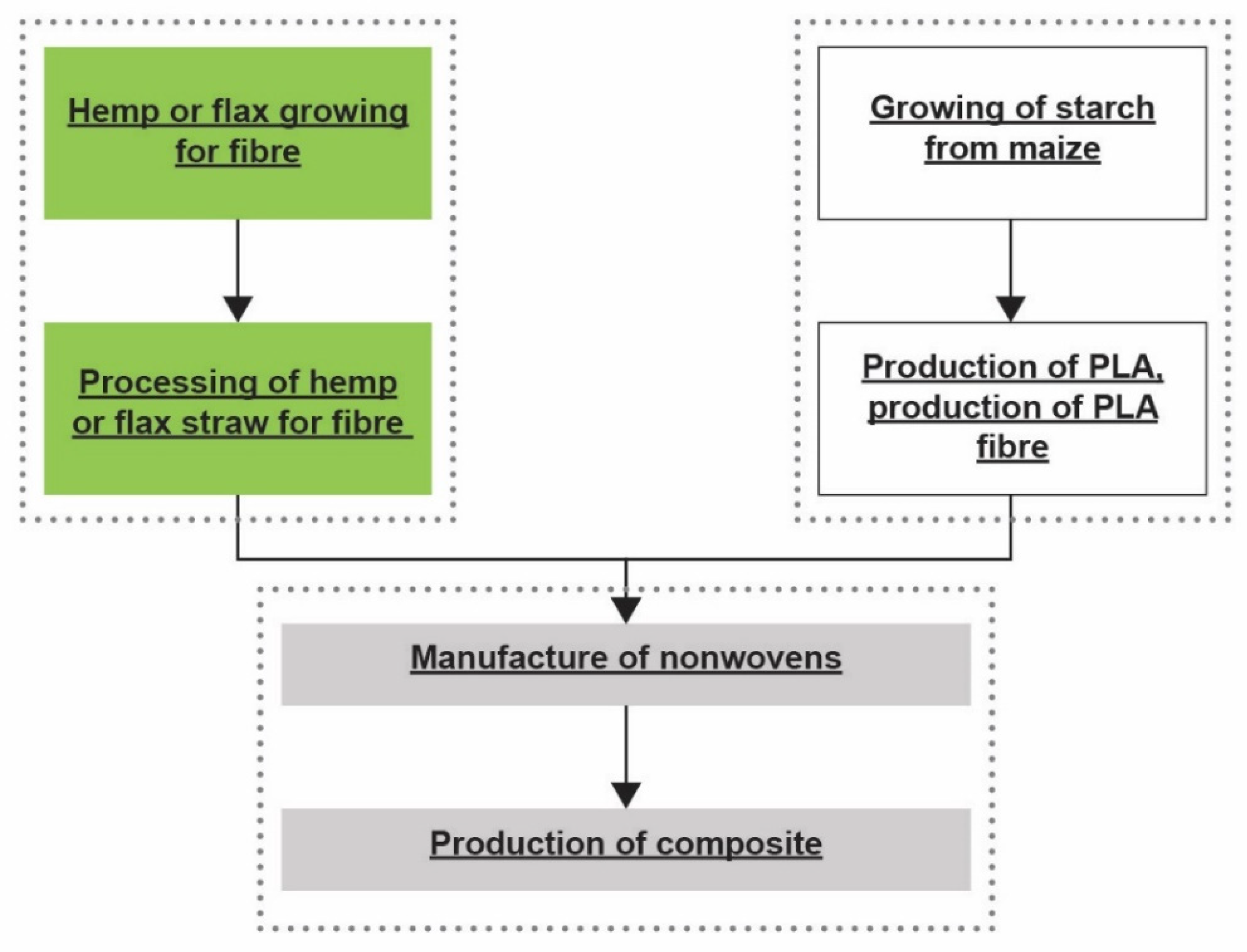

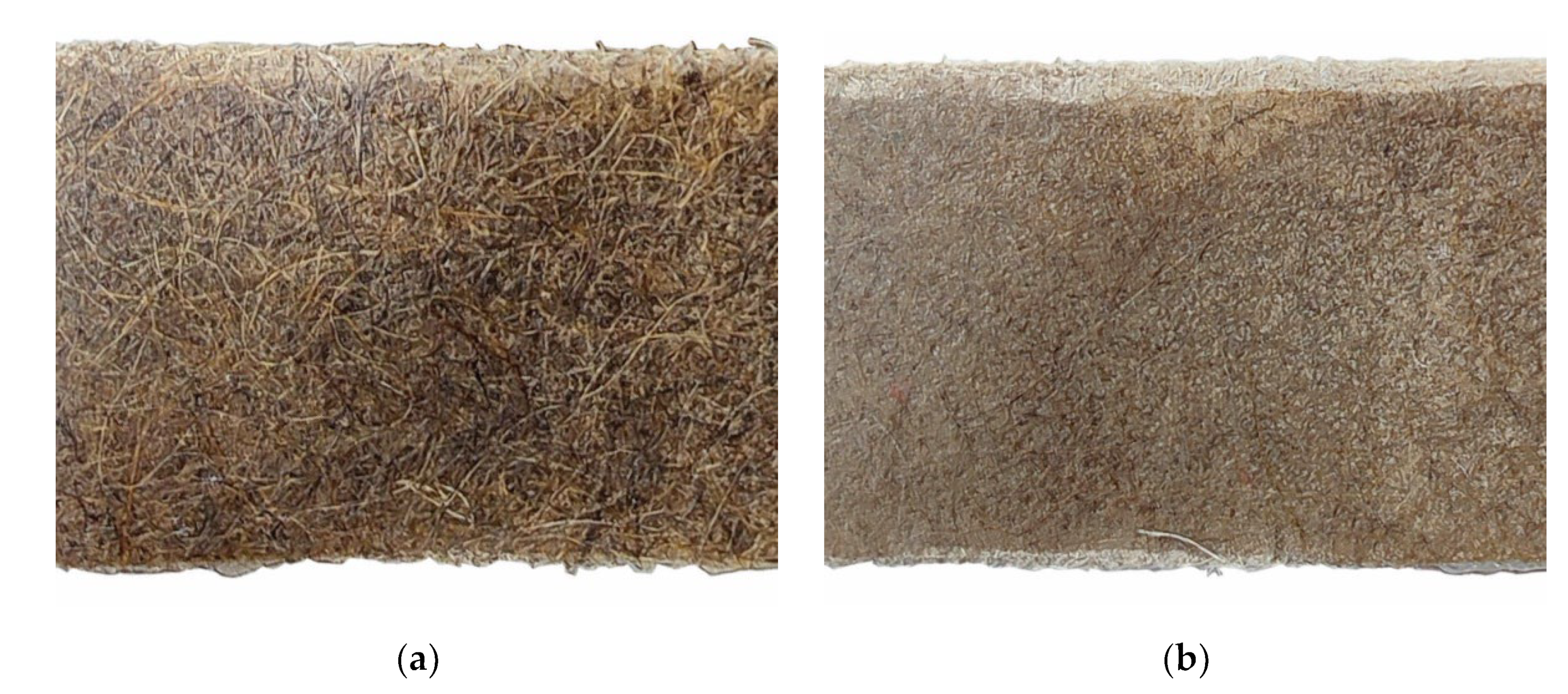
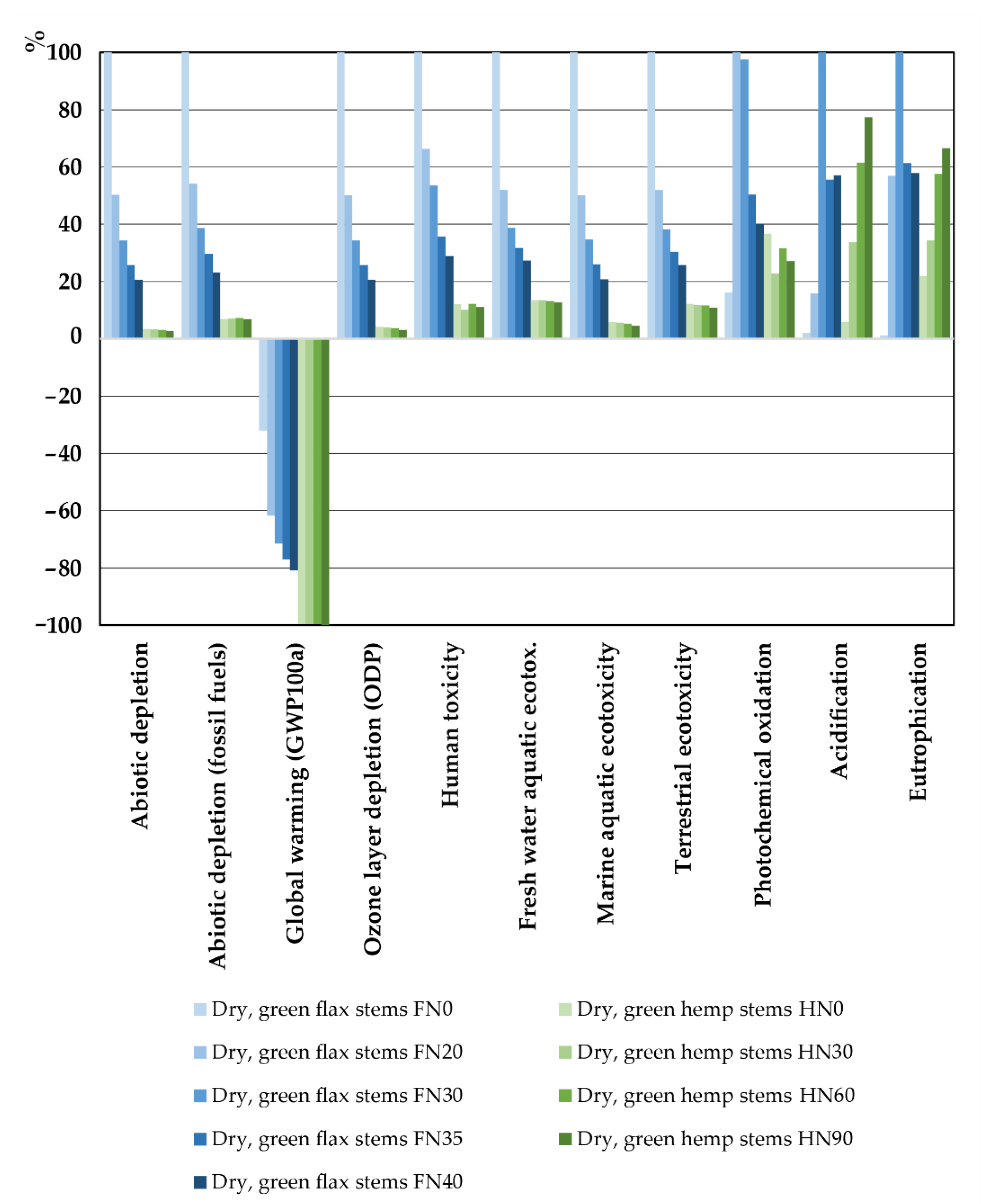
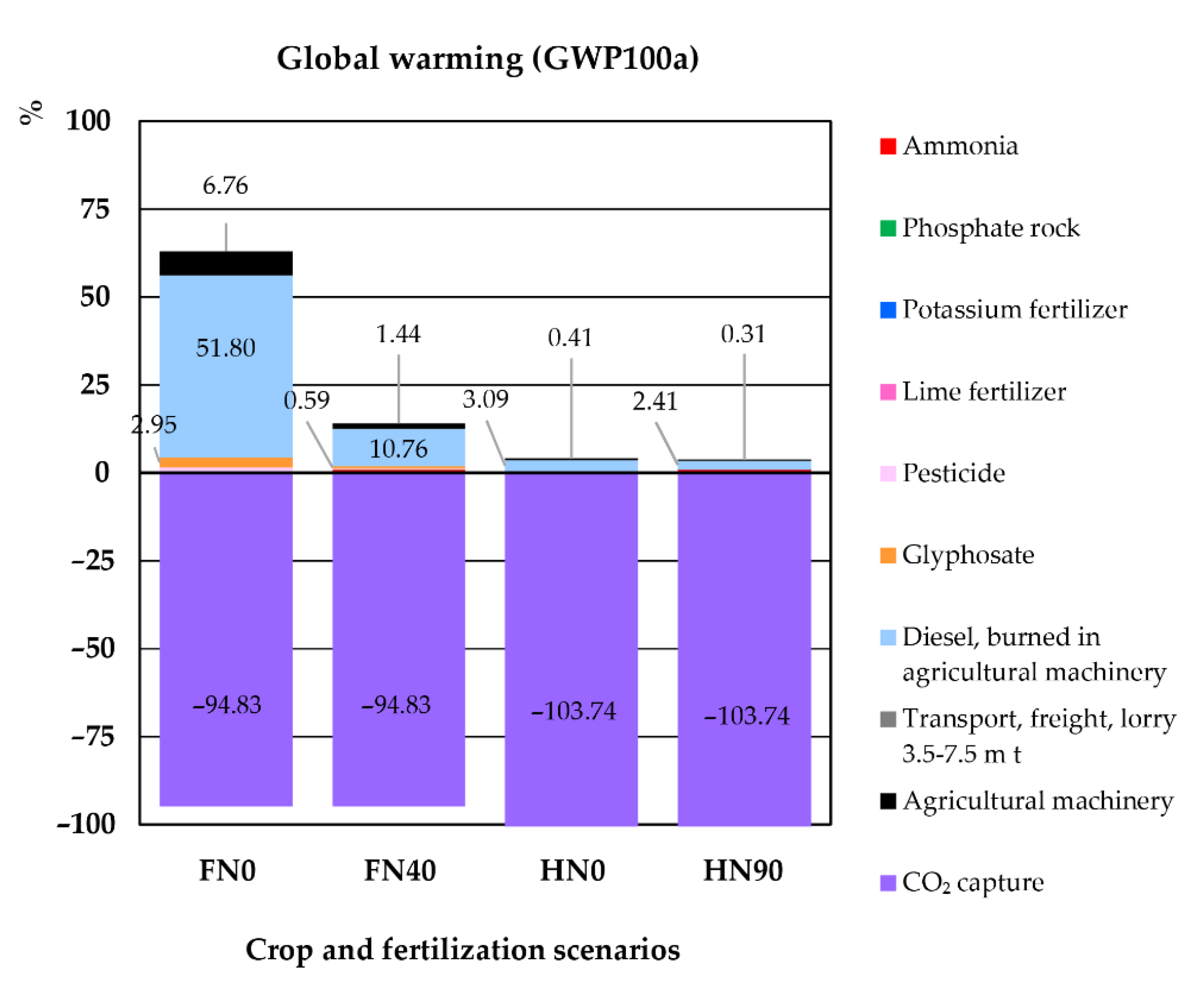
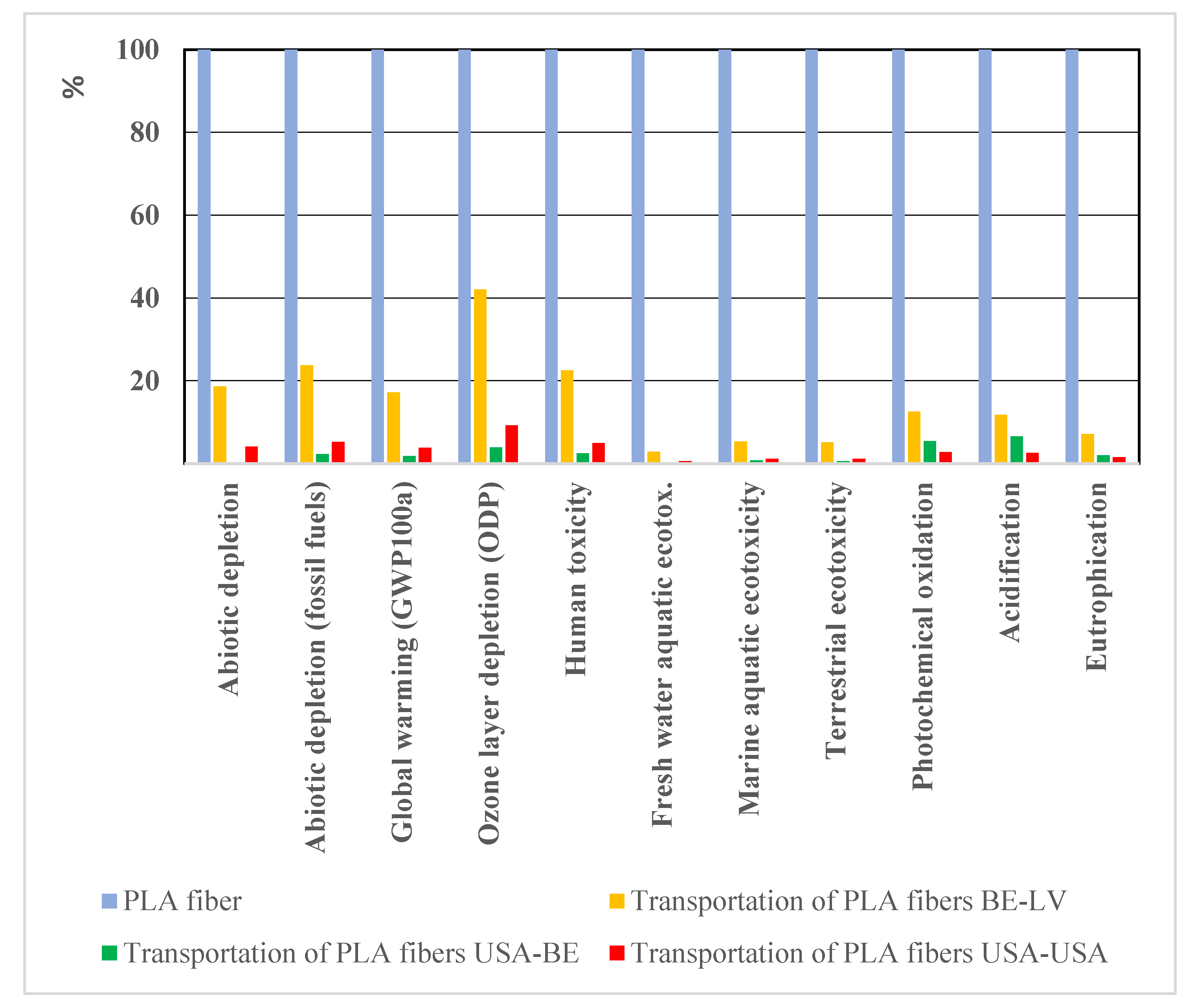
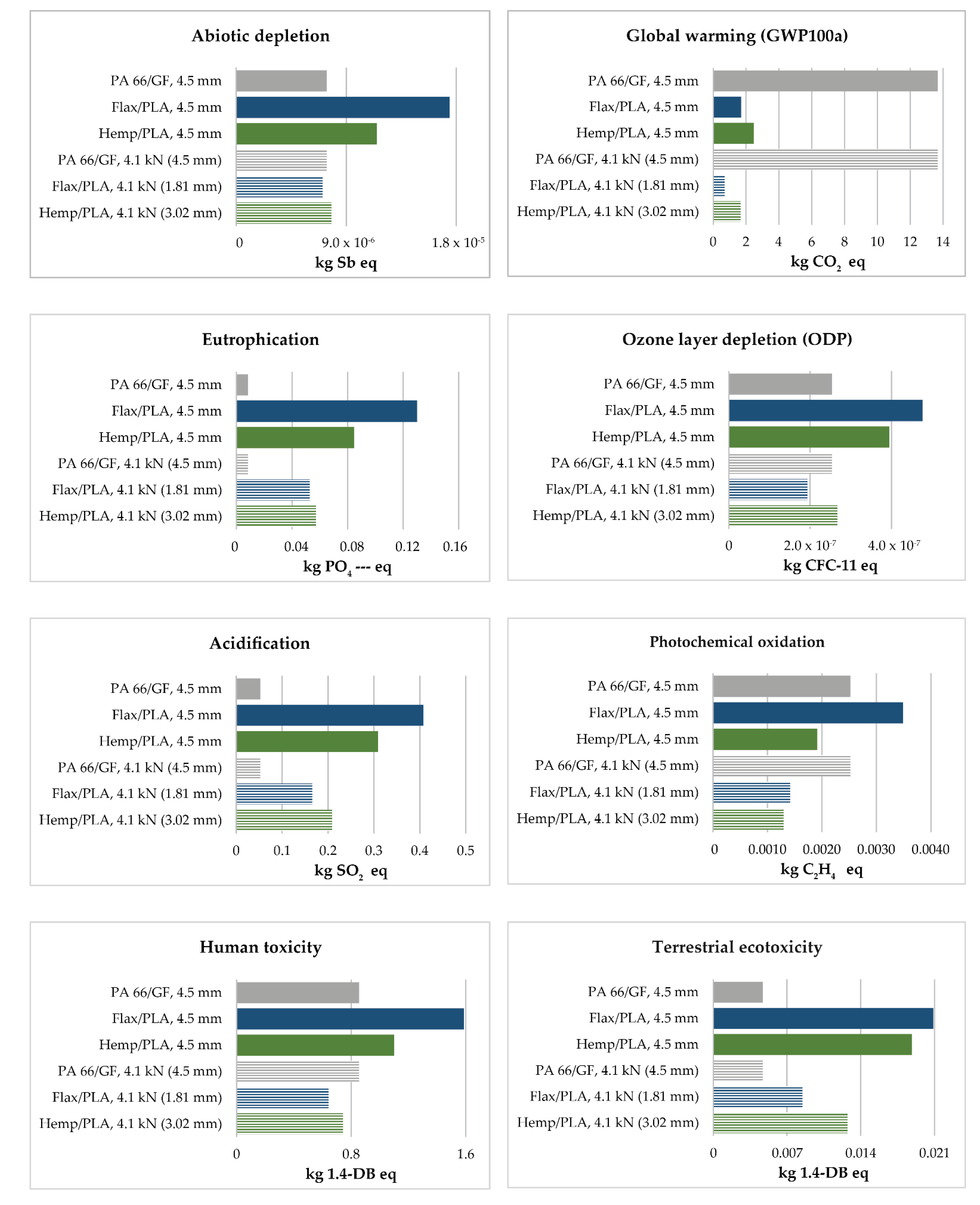

Publisher’s Note: MDPI stays neutral with regard to jurisdictional claims in published maps and institutional affiliations. |
© 2022 by the authors. Licensee MDPI, Basel, Switzerland. This article is an open access article distributed under the terms and conditions of the Creative Commons Attribution (CC BY) license (https://creativecommons.org/licenses/by/4.0/).
Share and Cite
Seile, A.; Spurina, E.; Sinka, M. Reducing Global Warming Potential Impact of Bio-Based Composites Based of LCA. Fibers 2022, 10, 79. https://doi.org/10.3390/fib10090079
Seile A, Spurina E, Sinka M. Reducing Global Warming Potential Impact of Bio-Based Composites Based of LCA. Fibers. 2022; 10(9):79. https://doi.org/10.3390/fib10090079
Chicago/Turabian StyleSeile, Arta, Ella Spurina, and Maris Sinka. 2022. "Reducing Global Warming Potential Impact of Bio-Based Composites Based of LCA" Fibers 10, no. 9: 79. https://doi.org/10.3390/fib10090079
APA StyleSeile, A., Spurina, E., & Sinka, M. (2022). Reducing Global Warming Potential Impact of Bio-Based Composites Based of LCA. Fibers, 10(9), 79. https://doi.org/10.3390/fib10090079




